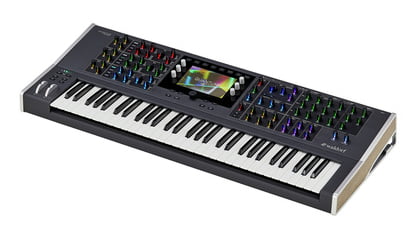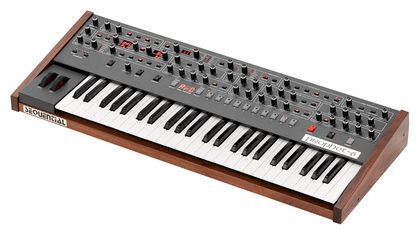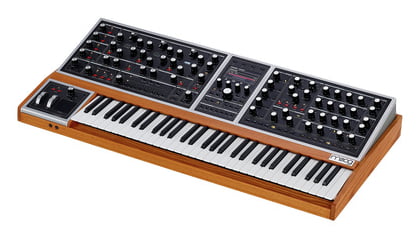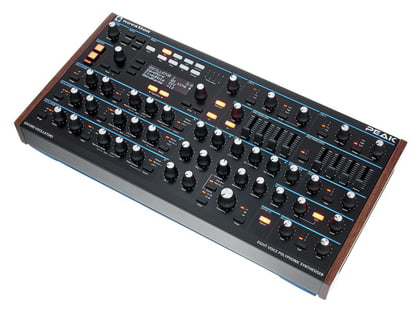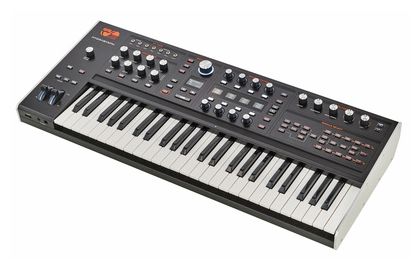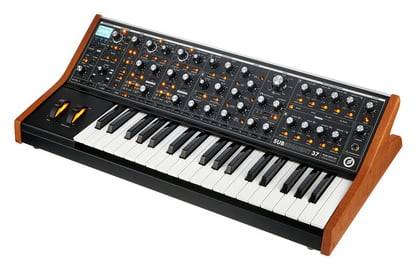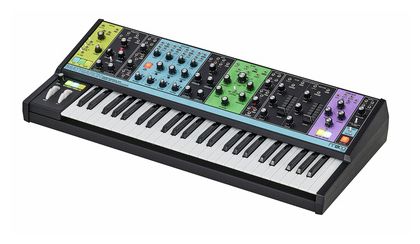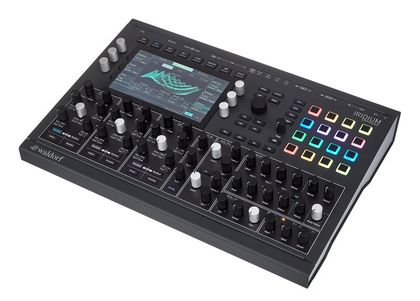Top 9 Access Virus TI2 Synth Alternatives For Unique Sound Design
1. Waldorf Quantum
Replaced with Quantum MK2
The quantum by Waldorf is a bi-timbral polyphonic (8 voices) synthesizer with high-quality stereo oscillators that can route through two sets of filters, multiple LFOs, and envelopes. We can do layering and splitting of the sounds with a flexible allotment of voices in oscillators.
It’s a futuristic hybrid synthesizer of both digital and analog characteristics, which is based on four synthesis programming; on top of that, you can do complex modulations and apply effects. This instrument has been elegantly, uniquely, and efficiently designed by Axel Hartmann, with great simplification and ease of use.
Key Features:
- Signal Flow
Apart from the three oscillators per voice, dual analog and single digital filters are available per voice. Therefore, modulation can be easily performed and applied using six envelopes and six LFOs (each with Sine / Triangle / Square / Sawtooth Down /Sawtooth Up / Sample & Hold).
Lastly, the signal flow is flexible and could route anywhere between the oscillator, filter, digital, former, amplifier, etc. You can connect up to five different effects units and use its extensive modulation matrix and compressor.
- Multi-synthesis algorithm
Four algorithms are available for synthesis: wavetable synthesis, waveform synthesis, granular synthesis, and sampling/resonator. Wavetable synthesis gives you a lot of flexibility in changing the core waveform of the sound.
You can experiment with the timbre of a sound using the granular synthesis algorithm, its time scaling options, and playing around with the sample’s phase, speed, and volume. Resonator synthesis is based on manipulating your samples using cross-coupled filters.
- High-functioning performance tools
Many tools like a pitch-modulation wheel, modulation pad, sequencer, arpeggiator, etc., are available for real-time performance and modulations of sounds.
In addition, there are functions like glide, hold, chord, mono, and unison available for better shaping your sounds, along with 61 velocity-sensitive piano keys, microtonal pitch configuration, and an oscilloscope.
Character & Sound:
The sounds are wide, warm, and huge-sounding due to multiple laying of voices, stereophony, ear-candy wavetables, and multiple effects. It’s a great synth for creating all types of sonics, ranging from plucky danceable sounds to warm, spread-out, and lush ambient sounds to groovy arpeggios and time-sequenced tunes.
In addition, the granular synth allows you to create futuristic and digital experimental music, like eight-bit music. It’s also great for creating pads and atmospheric sounds.
Pros:
The Quantum is a versatile digital synthesizer that store up to 10,000 patches, which could quickly recall using the Favourites list. Furthermore, Wavetables, samples, and presets can be exported and loaded using an SD Card. Hence, the sound design aspect of this synth is flexible because of the availability of different synthesis methods.
Visually it’s a stunning instrument with a touch screen display for controlling it. The knobs are high quality, the touch screen is smooth, and the overall design is intuitive and simple.
Cons:
The overall sound is not as analog as one would like. Hence, it’s not a one-in-all synthesizer, and you may need more tools in your arsenal to cover the analog spectrum of sounds.
Another huge con is that the filters are monophonic while the oscillator is stereo, which means that once the waveform passes through the filter, a mono filter is applied. One cannot connect a USB to it to load up patches, wavetables, and other data.
2. Roland SYSTEM-8
Roland SYSTEM-8 is an ABC-based polyphonic digital synthesizer that combines the best of worlds: classic and modern, together to produce a sonically diverse universe of vintage and futuristic sounds, owing to Roland’s tried and tested analog circuit behavior is at the core of its engine. which has proven itself over decades.
Historically, this derives from the digital synths revolution of the 1980s, which evolved from the multi-oscillator modulator synthesizers revolution in the 1970s, a golden period for analog music machines. After forty years of technological development at Roland, they have released the Roland System-8.
They have tried to capture the essence of the famous JUNO-6, JUPITER-8, and JX-3P, with their down-to-circuit recreations. This extension of the Roland S-1 uses an 8-voice polyphony, split & layered synths, an integrated vocoder, and three PLUG-OUT slots.
Key Features:
- PLUG-OUT Expansion
You get three expansion slots for connecting and controlling plug-out synths, by which you can load up a different sound engine, by which the Roland S-8 can be transformed into a different instrument. We can connect with many synthesizers and create interesting fused sounds using layered voices and custom splits.
- Easy Connectivity
In terms of connectivity, we can connect our rig using MIDI/USB and CV/Gate, can input and output audios using 2 1/4″ I/O slots, and can monitor the audio using the 1/4″ headphones slot. This makes it a great instrument for both LIVE and Music Studios.
- Advanced Sound Engine & Digital FX
Based on the architecture of S-1, this digital instrument is packed with the ABC Sound Engine by Roland, 3-variable oscillators with eight notes of polyphony, 25 & 49 keys, an arpeggiator to enhance your musical performance, a step-sequencer, an SD Card Slot, and effects like Delay, Chorus, Phaser, Overdrive, Flanger, Reverb, etc., by which you could extensively morph your sonic palette.
- Great sound-shaping capabilities
Apart from that, dozens of knobs, buttons, and sliders are available, giving us good intuitive real-time control over the sound design process. There are lots of modulation & filter options also available to shape the sound as per your taste.
You can change between 6 unique waveforms (saw, square, triangle, super saw, super square, super triangle) using the WAVE knob and blend these waveforms using the modulations.
Character & Sound:
Versatility is a huge plus for this synth, with a good variety of waveforms, a NOISE SAW, modulations like Frequency Modulation, SYNC, Vowel, Cowbell, Ring Modulation, Pulse Width Modulation, Cross Modulation, Detuning option, and a lot of other programming options like AMP Envelopes (Strings, Organ, Mallet, etc.), LFO of 6 different wave shapes, an arpeggiator, and a sequencer.
You can also add interesting effects like delay, reverb, chorus, flanger, etc., to improve your sounds. All the options mentioned above allow you to shape and enhance your sounds per your taste and create a wide range of sonics, letting you create sounds that are both vintage and modern.
Pros:
Regarding connectivity, we can connect our rig using MIDI/USB and CV/Gate. That makes it easy to work with, carrying it around while traveling, and the plug-out option helps you expand your instrument further. That is a great plus for both touring and studio musicians.
Using the MIDI connectivity, you can work with it on a computer or laptop too, and program & record music on your DAWs.
Small size, with only 13 lbs of weight, makes the Roland S-8 a portable tool. Moreover, it does a remarkable job sonically emulating classic synths: the Juno-6, Jupiter-8 & JX-3P. Hence, you need not spend a tonne of money on buying analog synths when you can buy a digital synthesizer with such capabilities and functionalities.
Cons:
The biggest drawback of the S-8 is that it has very few patches, which are uneditable during the performance, and that it does not have much performance memory. Along with that, the performance mode does not save edits.
In addition, its documentation is below average, and the hardware is made of plastic and has an external power supply.
There’s no option to connect an XLR mic input, and it is not great for keyboard players as it has few octaves. Lastly, the arpeggiator doesn’t have a gate or swing mode, only one global LFO, and the sequencer doesn’t have a metronome track.
3. Sequential Prophet-6
The Sequential Prophet 6, a successor of the much renowned Prophet 5, is a 6-voice analog synthesizer that comes with two voltage-controlled oscillators (VCOs) per voice, giving us an option to use up to twelve oscillators at a time. Known for its authentic and warm vintage tone, we can smoothly transition the oscillators of this synth from triangle to pulse.
It also has a slop knob that emulates the inconsistencies between oscillators in old analog synthesizers, outputting a fat synth sound from detuning and dephasing the voices. Created by Dave Smith, the creator of the Prophet 5, this machine exceeds all expectations with its classic sequential circuit, which gives it its analog characteristics.
This synth has its fan base and a great reputation in the market for its trademark sound, which is loved by almost anyone who uses it, and its legacy. It has four octaves of piano keys and a button to shift octaves.
Key Features:
- Studio Quality Effects
The Prophet 6 packs a dual effects section with studio-grade digital effects like reverb, phase shifter, chorus, delay., etc., which are bypassable to maintain the analog nature of the synth. There’s also a stereo distortion effect which is completely analog.
- Poly Modulation & Step Sequencer
A filter envelope and the second oscillator act like modulation sources, targeting various parameters of oscillator one that could be used for modulation purposes. It has a polyphonic step sequencer with up to steps and up to 6 notes on each step, which allows polyphonic sequencing. There are two filters per voice and a multimode arpeggiator available as well.
- Ease of use
Five hundred factory and 500 user programs are available as patches, which can be easily manipulated and played around to create interesting sounds. Apart from that, there’s a MIDI output, a USB slot, two audio outputs of 1/4″ each, and a headphones output.
Character & Sound:
You can expect to create sounds with a lot of movement, depth, punch, and fullness when you work with this synth, giving you a great analog-natured vintage palette.
The factory presets have a huge variety of sounds ranging from plucks to percussions to spread-out ambient sounds, proving the versatility and capabilities of the Prophet 6. In addition, things like the Slop dial and effects range are created for us to shape the sounds as per our taste.
Pros:
The semi-weighted keyboard of this synth feels very smooth to play, with an accurate velocity-sensitive and aftertouch response to the finger pressure. The VCOs, VCFs, and VCAs are perfect for the aesthetic vintage sound.
The user interface is simplified and easily usable, and the performance is more ear-dependent than giving you fancy visual cues about what you’re doing.
Cons:
Since the Prophet 5 and the Prophet 600 had a five-octave keyboard, many fans were disappointed when the Prophet 6 was announced as a four-octave keyboard synth. This makes it portable & compact, but it’s not the best fit for performing musicians & sound designers who play with both hands.
It’s also expensive and not easily affordable. Finally, it uses digitally sourced LFOs and ADSR contours that technically make this machine a bit digital, which may put off analog purists and old Prophet fans.
4. Moog One (Analog Synth)
Moog launched its first polyphonic Moog synthesizer in thirty years, called Moog One.
It’s a tri-timbral analog synth with great capabilities in terms of the richness & punch of the sound, and a state-of-the-art design, and is capable of generating fat and punchy bass sounds. Physically, it’s a large machine that requires a lot of space.
The front panel features single-function knobs like oscillators, filters, envelopes, and LFOs together by module. We can also add digital effects to our sounds, but for the purists and the fans of analog sounds, we also have the option to bypass the digital effects, if we want it to be 100% analog.
Packed with up to 48 voices, digital synth effects, a 20-slot modulation matrix, various input/output and control options, an arpeggiator, and a 64-step polyphonic sequencer, this is a highly ambitious piece of equipment.
However, the central control section with a large screen to search and browse presets and its laid-out knobs & buttons make the workflow easier.
The analog circuits of Moog are known for their richness, harmonic nature, and natural quality basslines, due to which Moog has been one of the primary instruments of artists/bands like George Harrison, Beastie Boys, The Doors, etc. Moog One is also widely used in programming groovy basslines for West Coast/G-Funk, club genres, and various other styles.
This synthesizer carries that nature of sound, along with its elaborate programming capabilities, and polyphonic & multitimbral character, which gives you a good combination of classic analog sound and modern tech to manipulate and shape the sound.
Key Features:
- Cutting-edge Sound Design Capabilities
Moog one comes in 8- and 16-voice versions and three Voltage Controlled Oscillators (VCOs), that is, up to 48 voices at once, and also packs two independent analog filters- Variable State filter and Moog Ladder filter, giving the perfect analog texture of fatness to design bass sounds.
- Rich Waveforms & Premium Modulation Options
The 3 oscillators could output a user-defined blend of triangle/saw and square/pulse oscillators, giving it a harmonically rich texture. To that, digital modulations like Ring Modulation, Frequency Modulation, Hard Sync, etc., can be applied for grittier bass.
There’s an option to add a dual-source noise (pink, white, red, purple, etc.) generator with its own envelope shaper, which can give you a sound with full-spectrum and transient capabilities.
- Ease of Creation
With more than 73 knobs and 144 buttons, and 61 keys, the Moog synthesizer is designed to spark creativity. It’s a great technology due to its innovative bass design and ease of use.
You can save tens of thousands of presets and can also recall a time-stamped snapshot of a preset using an LCD center panel, in which you can browse and control different presets and settings.
- Analog-Digital features
You can also use digital effects on your synths and master output, for example, the eventide reverb (Room, Shimmer, Hall, Blackhole, and Plate) and other high-quality effects of distortion, compression, etc., for versatile bass sound design.
- Modulations
The four LFOs, and three DAHDSR Envelope Generators can be applied in series or parallel to each voice, to further add sonic depth and movement to your basslines.
- Easy connectivity
There are 2 x 1/4″ stereo headphone outputs, 1 x ¼” external audio input (line-level), 4 x ¼” hardware inserts (TRS), 1 XLR + ¼” TRS combo external audio input, 9 assignable CV/GATE I/O (5-in/4-out), a LAN port, and USB drive support for saving and backing up system settings and presets.
Pros:
The tone generators, filters, and modulators in this machine are high quality and the best you would find. On top of that, it’s tri-timbral, which essentially makes it a three-in-one synthesizer, along with which its interface is intuitive and well-thought-out, with very few hidden features. You can do a lot more than create basslines with the synthesizer.
It has a great sound design workflow and the ease of applying modulations, filters, and effects make it stand out. The Moog one is a reliable gadget with a rich & vast sonic universe, owing to its classic Moog circuitry, which gives this machine a sweet, warm, and unique analog low end & overall tonality.
Film & Music studios, sound designers, and engineers who are looking for a machine with uncompromising abilities, who do not have any constraints on the budget, and who have a good know-how of how analog synthesis works are the ideal customers for the Moog One.
Cons:
Priced at $8,999, many bedroom music producers cannot afford to buy such an expensive machine. However, it’s only designed for premium music and film studios. Apart from being pricy, this is a heavy machine and weighs about 45 lbs, making it quite challenging to carry around.
The Moog One is also huge in size, with an area of 7 x 42 square inches. Lastly, it’s complex and not easy to use and it could take a while to get used to its workflow, especially for beginner sound designers & music producers. Unfortunately, it’s ahead of its time and may not be the best product-market-fit.
5. Novation Peak
The Novation Peak is an 8-voice polyphonic virtual analog synthesizer with analog waveform– and digital wavetable oscillators, built to work with computers, bridging the worlds of analog and digital.
This synth is perfect for sound design in the modern electronic music era.
Therefore, it could be well utilized by bedroom producers, performing DJs, and even high-end studios. Furthermore, you can easily utilize it for more complicated modulations and routings, as, for example, the modulation matrix can have up to 17 sources and 40 destinations. But first, let’s look deeper into the main features of this machine.
Key Features:
- Oxford Oscillators
Oxford Oscillators are based on FPGA (Field Programmable Gate Array), which creates less aliasing, hence adding more analog characteristics to the sounds. In addition, there are three oscillators with multiple analog waveshapes like sine, sawtooth, triangle, and pulse width, and 60 digital wavetables from which we could choose multiple waveforms.
- Limitless Modulation
There are 16 direct modulation assignments and a 16-slot modulation matrix that you can assign to introduce more movement to your sounds. Moreover, using the FX Modulation matrix, you can apply modulations to any effects. You can modulate almost anything on the Novation Peak with these many options.
- Wavetable Editor
The wavetable oscillator in this instrument comes with an editor which allows you to edit and even draw waveforms and oscillator shapes. You can even create waveforms from external audio samples with the Audio Import function.
Character & Sound:
Direct control of all onboard effects gives you a lot of scope for sonic shaping. For example, using effects like delay and reverb to make ambient sounds and modulation controls to create metallic texture, harsher tones, musical overtones, and dynamic movements.
Being a virtual analog synth with much more control and knobs & sliders for effects & modulations, one can create smooth and warm classic sounds and dirty & granular underground sounds. One can also use the noise generators and modulate them to create soothing windy sounds.
Pros:
As a digital-analog hybrid synth, Peak offers features you will not find in a traditional analog synth, including various wavetables. Further, it’s a versatile and all-in-one synthesizer and offers a good ROI for its price. Lastly, it has high-quality oscillators, a friendly laid-out structure to sound design, and analog multi-mode filters and effects.
Cons:
The biggest con of the Novation Peak is that you cannot use and load your wavetables in it. Instead, you get a wavetable editor, which makes the matter more complex and time-consuming, given that the in-built wavetables are slightly underwhelming. Further, it does not have a keyboard and is not rackmountable.
6. ASM Hydrasynth Keyboard
The Hydrasynth is a digital instrument with 8-voice polyphony that comes in two different versions. One comes with a velocity-sensitive 49-keys keyboard with polyphonic aftertouch, and another comes in a desktop version. Both are fully digital synths with virtual analog FM and wavetable oscillators, five envelopes and five LFOs per voice, and an extensive effects section.
The Hydrasynth is the debut synthesizer of Ashun Sound Machines, a Chinese company. They priced it at about $1299, which is pretty affordable, given its advanced features and innovative design.
Key Features:
- Next Level Virtual Analog sound design capabilities
The ASM Hydrasynth packs a 32-slot modulation matrix, three Wavescan oscillators with 219 waveforms, and four waveshaping mutators. Each of the five envelopes can sweep through exponential and logarithmic curves, which creates scope for long evolving modulations. Further, the LFOs have 11 different assignable waveforms.
- High-performance Parameters
For live sound designing and performances, the ribbon controller gives you accessibility to control pitch bend or modulation amount.
PolyTouch gives you more command over the aftertouch curves, offsets, and release times, shaping your sounds in more controlled and creative ways. Lastly, it also gives you macro controls, that is, ways by which you could control multiple parameters by just a single knob.
- Hands-on control of the interface
The intuitive interface makes your sound design process simpler and easier, with plenty of knobs and buttons to tweak what you’re looking for. In addition, we can easily access each section and functionality of this synth with just a press of a button.
Character & Sound:
ASM places a lot of importance on recording the expression of the performance by packing the Hydrasynth keyboard with aftertouch, connectivity for sustain peddles, and velocity sensitivity. Hence, what you play on this instrument will truly be recorded. Moreover, sonically, it sounds fairly analog and warm for a digital synthesizer.
You can create anything from a pad to a pluck sound to percussions to fat and gritty synth bass sounds to strings with varying ADSRs to punchy and bright 80s stabs, etc., hence making it a good sound design tool for modern music producers.
Pros:
Hydrasynth combines several sound design methods, like wavetable synthesis, subtractive synthesis, linear FM, Pulse Width Modulation, and more which gives it limitless functionality.
Further, eight macro control presents make the sound design workflow easier, combined with a solid build and a high-quality effects section. Lastly, the Polyphonic aftertouch and Ribbon Controller are its topmost USP after its attractive price point.
Cons:
The keyboard is 49 keys long, and some sound designers may have a preference for longer keyboards to be able to record their performances easily. Secondly, it has an external power supply, and the complex & overwhelming sound design workflow may take time to get used to.
Hence, Hydrasynth is not the most beginner-friendly sound design instrument. Lastly, lacking sequencers could be a huge dealbreaker for many sound designers, making its versatility questionable.
7. Moog Subsequent 37 (Analog Synth)
Subsequent 37 by Moog is a 37-key analog synthesizer with a re-tuned multidrive circuit and great power.
It features a 3 octaves, long velocity sensitive keyboard in an analog/digital hybrid model with an analog signal path and digital controls. It also has a well-built physical structure made of steel and wood, and its duophonic mode makes it great for performance.
Key Features:
- Duo mode
The Sub 37’s duo mode allows you to play the oscillators separately or together, so both of them can play a different note simultaneously. So, for example, you can hold a bass note, play a lead over it, and play in different harmonic intervals.
- Get handy
You get immense hands-on control of the device with 37 after-touch playable keys, 40 tweakable knobs, and 74 switches waiting to be manipulated and played with. Diving into menus is not an option when you get such command over your synthesizer.
- Multidrive circuit
The detuned multidrive circuit gives you enhanced gain and higher dynamic range to blast more aggressive, dirtier, and grittier analog-sounding basslines. It also gives you more headroom to enhance the signal, for example, by boosting its harmonic processing.
- Versatile & Easy Synth Engine
You get 256 presets to get started with in sixteen different banks of sixteen patches, covering various types of sounds. In addition, it features the famous smooth Moog filter with resonance, MultiDrive, and selectable slope controls. On top of that, there are two modulation buses and a DAHDSR envelope with sync.
Character & Sound:
Overall it’s a great synthesizer for creating bass sounds of various kinds, whether you want something funky, something plucky, something smooth, or even aggressive. From creating 80s-style bass to wobbly bass to Reese bass to portamento bass, you can do it all.
Pros
The synth’s versatility and ease of use, given its silky smooth interface, compact size, and velocity-sensitive keys with aftertouch, make it great for studio and live purposes. It’s great for all genres and styles of bass.
Cons
The arpeggios, sequencers, and modulation controls are not as intuitive and require some menu diving. Secondly, it’s expensive, given the features it offers are not significantly enough different from the Sub-37.
Further, it’s too difficult to navigate menus with just three buttons, and the lack of CV/Gate inputs makes its connectivity questionable. Overall, it could be less buggy and cleaner.
8. Matriarch
The Matriarch is the fourth installment in Moog’s line of semi-modular synthesizers. Following the Grandmother, the Matriarch adds more functionality, keeps the colorful, pastel paint job, and provides the staple Moog tone many have come to love.
Moog’s Matriarch is a 4-note paraphonic, semi-modular synthesizer with Eurorack support. It offers four VCOs, Moog’s ladder filter, two EGs, a stereo delay, an arpeggiator, and a powerful sequencer. Additionally, you can seamlessly modulate various parameters using the synth’s 90 patch points.
Key Features:
- Four Oscillators
Up to 4 oscillators create a rich and diverse range of sounds. Each oscillator can be set to play within 4-octave ranges. To design your sound, you can switch between four waveforms for each oscillator: triangle, sawtooth, square, or a narrow pulse wave. In addition, you can set the synth to play monophonically, duophonically, or paraphonically.
- Classic Moog Filter
The filter is based on the classic Moog 904A module. However, it offers more than just pure low-pass filtering like its inspiration. There are three selectable filters: series LP/HP, Stereo LP/LP, and Parallel HP/LP. The first creates a band-pass filter, the second a stereo signal path, and the third a notch filter.
- Two ADSR Envelope Generators
You are offered full envelope customization of the filter and the amplitude through the two envelope generators. The EGs can control the attack, decay, sustain, and release to sculpt your sounds exactly how you want.
- Stereo Delay
You can use a built-in stereo or ping-pong delay to add vibrancy and depth to your synthesized tones. The stereo delay module is based on the Moog 500 Series Analog Delay but offers shorter delay times ranging from 35 msec to 780 msec.
However, if synced with a clock, you can use the time dial to alter the delay times within divisions or multiplications of the tempo to create ambiently trippy arrangements.
- Sequencer
The Matriarch’s arpeggiator is precisely the same as the Moog Grandmother’s. However, the sequencer has been expanded upon. You will be able to store up to 12 sequences. Each sequence can contain 256 steps or 1024 notes (Each step comprises four notes).
Overall, the interface is highly intuitive, and you will have an ocean of deep, warm, and smooth sounds to lose yourself. The analog tones are exquisite and don’t require much external modulation to shine.
However, once you use the patch bay to connect external modules, the tonal options increase exponentially. If you want to hear some of the possible sounds created by a Moog, you can find sound samples here on Moog’s Soundcloud page.
Pros:
The optional oscillator sync function can thicken the sound substantially to create a sonic bulldozer that can stand up well in a mix. Couple the sync function with the option to switch to two or four-note paraphony, and you have a versatile synth that can excel in many situations.
Moog does offer a dark version with an all-black paint job if you aren’t a fan of the pastel-colored interface.
Cons:
Much like the DFAM, you will be unable to save presets. The only workaround at the moment would be to take photos of the parameters and refer back to them when you need to recreate a sound.
Otherwise, Moog has printable blank patch sheets you can use to record any setups you’ve come up with. One of the more annoying cons you will come across is an issue with the internal clock swaying out of time when syncing the delay to the arpeggiator/sequencer.
9. Waldorf Iridium
The Waldorf Iridium is a sixteen-voice polyphonic bi-timbral stereo digital hardware synth; and is the desktop version of Waldorf Quantum and includes Quantum’s analog filters for a lower price tag, more voices, smaller footprint, and a few more features.
In addition, it includes five synth engines: wavetable, waveform, sampler/granular, resonator, and kernels.
Key Features:
- Sharp & interactive touch screen
It has a seven-inch color touch screen that is sharp, viewable from any angle, and has a good response rate to touches, whether light or hard.
You could use this to access and save presets, select effects, oscillators, and modulators, analyze waveforms using its oscilloscope, decide the signal flow, etc. In addition, the touch screen allows you to cycle through different waveforms in the wavetable.
- Solid built
The synth is heavy and well-built, the encoders and knobs are solid and responsive, and the pads are good quality. It doesn’t have a built-in keyboard, but you can use its pads, arranged chromatically, to play or record any chords or notes. Chords can be customized to single pads as well in chord mode.
- Limitless sound design capabilities
Packed with powerful modulators, the Iridium has a 40-slot modulation matrix, dual filter, six envelope generators, 4×4 pad matrix, six LFOs, and a KOMPLEX modulator which offers highly accurate and precise sound shaping options. As a sound designer, you can utilize comb filtering, bit crushing, Ring Modulation, and many other modulation & effect tools.
Character & Sound:
With 16-voice polyphony and dual-timbral mode, the Iridium can produce highly dense and filled sounds. Given its five different synth engines, the range of sounds one can produce is huge. There’s no limit to what can be done with this machine, as we can utilize it equally well for different genres of music, game sound design, and film scoring.
For example, wavetable synthesis can be used to create morphing sounds with interesting movements and attitudes, resonator synthesis can manipulate the overtones & harmonic structure of any given sound, and waveform synthesis could be utilized to create sounds of more analog nature.
The oscillators and modulation tools are high quality, clean and modern, and can be used to create a wide variety of sounds.
Pros:
It’s an all-in-one machine that blends lots of features well together, creating a seamless user interface, given the number of knobs, buttons, and touch screens we can use to control thousands of parameters.
Further, we can conveniently do many things with the touch screen, like sequencing, arpeggiating, and scrolling around through different waveforms and presets.
Lastly, the screen animations are useful and interactive for visualizing the wavetables, LFOs, modulations, etc. Physically, it looks stunning and compactly packs all features & capabilities of the Waldorf Quantum.
Cons:
Only 600 MB of memory is available for loading up samples or wavetables, which could be expanded to 2.5 GB if you clear the factory presets. Further, the pads are really small and have no pressure after-touch sensitivity. Further, it does not have an SD card or USB stick slot to use or expert external data. Lastly, there are no macro controls, which, if included, could enhance this machine’s performance.

Integraudio is an audio blog made specifically for musicians and those seeking audio knowledge.


